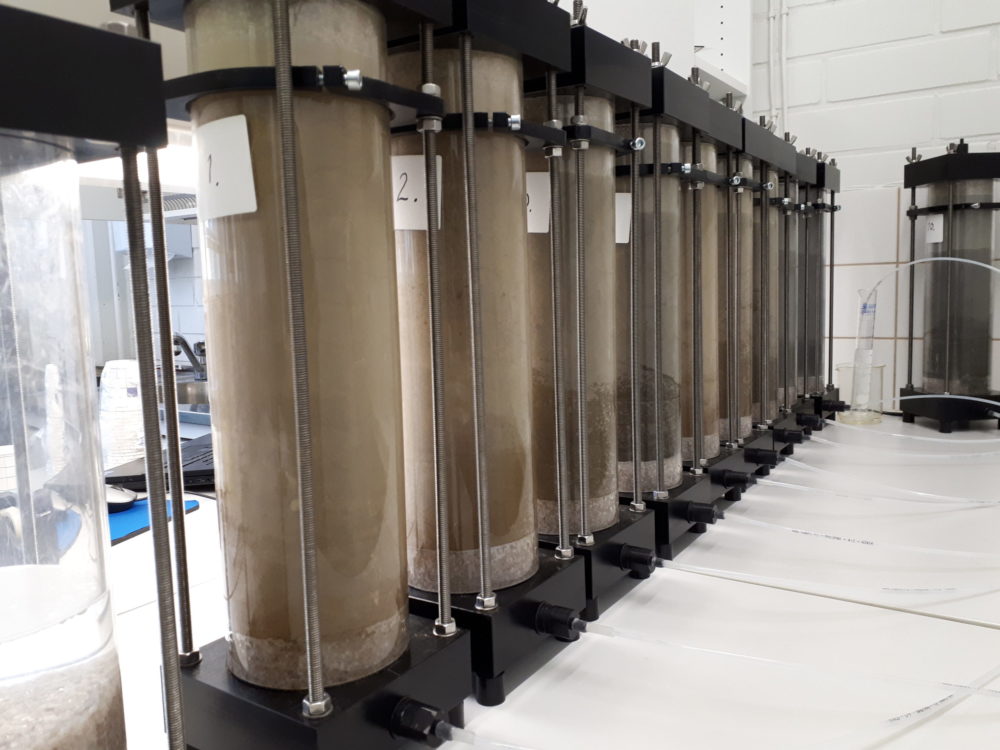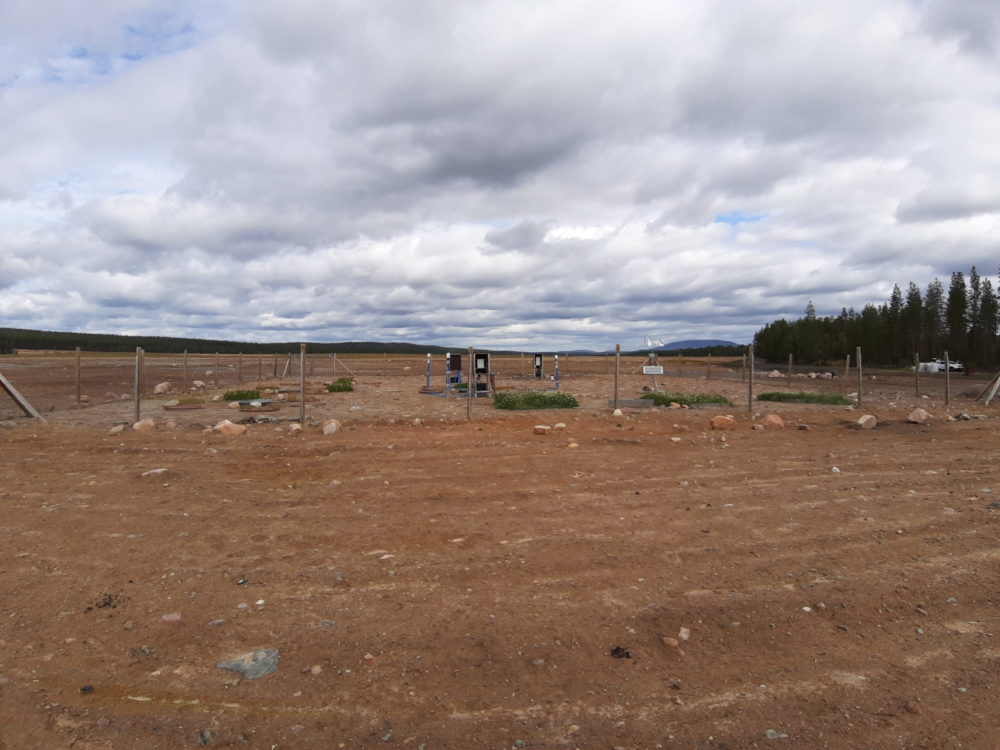Science Blog: Biochar – The black diamond for tomorrow’s rehabilitation in mine closure?
Collaboration between the Geological Survey of Finland (GTK), Natural Resources Institute Finland (Luke) and the University of Oulu has aimed at promoting the “greener” closure of extractive waste facilities. The EDRF-funded Biopeitto project (“Utilization of biochar in the cover of extractive waste materials and landscaping”) investigated the effects of biochar on the water management, geochemistry and carbon and nutrient balance of the multilayer dry cover of extractive waste facilities. The key questions for the study were as follows: (1) Can the addition of biochar to the upper cover structure improve rehabilitation by boosting plant growth? (2) Does biochar affect the leachate and the physical properties of the cover structure?
Biochar
Biochar is by definition carbonised biomass obtained from sustainable sources and sequestered in soils to sustainably enhance their environmental or agricultural value under present and future management (Biochar for Sustainable Soils 2021). It is a charcoal-like material, but unlike charcoal, it is produced using a process called pyrolysis, in which organic material is burned in a container in a nearly oxygen-free atmosphere. During the process, the organic material is converted into biochar, a stable form of carbon. Biochar is a black, highly porous material and has a large surface area. Depending the success of the pyrolysis, approximately 80–90% of its composition could be carbon. The remaining percentage consists of nitrogen, hydrogen and other elements. Biochar’s chemical composition varies depending on the source material and methods used to make it (Regeneration International 2018).
Biochar is able to adsorb and immobilize heavy metals and organic chemicals and prevent nitrate leaching into waterways, as well as reduce N2O and CH4 emissions from soils (Biochar for Sustainable Soils 2021). However, the properties of biochar vary widely and are particularly affected by the raw material, the production temperature and the post-processing (e.g., Fe salts, phosphoric acid or potassium hydroxide). The grain size of biochar also plays an important role. For instance, a larger grain size is better for improving soil ventilation, whereas fine-grained biochar has a greater surface area to bind metals and serve as a substrate for microbes.
Biopeitto
In the Biopeitto project, the behaviour of the cover structure for extractive waste materials was investigated in tabletop column experiments under laboratory conditions and in pot experiments under greenhouse conditions. The column experiments were conducted to examine the long-term chemical stability of mining wastes and the effects of biochar on mine waste and till-cover geochemistry. This was done to monitor both the positive and negative effects of the biochar itself (Lahtinen 2020).

Biochar produced from four source materials was tested: Norway spruce (Picea abies), common silver birch (Betula pendula), waste wood chips from the construction industry and composted sewage sludge from a municipal waste facility. The biochar was sieved to a grain size of under 2 mm and mixed with till in three proportions: 1%, 5% and 10%. After the first test batch, the biochar produced from spruce was selected for an on-site lysimeter test with a 5 vol% ratio of the biochar in the upper 10 cm of the dry cover.
Column test materials
| Source material of biochar | Pyrolyser | Producer | Proportion of biochar in the cover material |
| Spruce | Retort | Noireco Oy | 1%, 5%, 10% |
| Birch | Retort | Noireco Oy | 1%, 5%, 10% |
| Waste wood chips | Retort | Luke | 5%, 10% |
| Composted sewage sludge | Retort | Luke | 5%, 10% |
| Spruce (2nd batch) | Retort | Noireco Oy | 5% |
| Birch (2nd batch) | Retort | Noireco Oy | 5% |
The aims of the greenhouse pot tests included examination of the effect of biochar produced from Norway spruce and common silver birch, dried waste paper sludge and composted sewage sludge mixed with tailings and till as a growth medium. The results suggest that forest till soil and biochar are the most suitable growth media for dry cover systems to be used on mine tailings when added with compost or another nitrogen source (Heiskanen et al. 2020).
A field study was carried out in the tailings area of the closed Rautuvaara mine in Kolari, where lysimeter and grid tests were performed to observe the effect of biochar on the leachate of cover solutions and the behaviour of various plants under northern climatic conditions. The addition of biochar was not found to have a direct effect on the leachate of the lysimeters, but the thickness of the cover layer was an essential factor influencing the amount of oxygen and water content of the cover layer, as well as its temperature and erosion resistance. The addition of biochar to the cover structure medium improved plant growth and water management, as well as the carbon and nutrient balance of herbaceous plants in particular. The results of the column and greenhouse pot tests, as well as the lysimeter and grid tests, were published in the project’s final report (Pietilä et al. 2020, in Finnish).

The project used HYDRUS-1D software to assess the water balance of the cover structure, while the Coop Model was used to assess the impact of different material ratios (tailings, till, biochar, compost) and climatic conditions on the water and temperature economy of the soil profile, as well as long-term plant success (Liwata-Kenttälä et al. 2020).
In the early phase of the project, a Webropol survey concerning cover solutions and biochar was carried out amongst mining operators, researchers, consultants and environmental authorities in Finland and Sweden. The project aimed to address the challenges identified in the survey, in particular the lack of research data and problems in accessing information. The results of the survey were published in a separate report, in which various cover materials and structures were also reviewed (Koivuhuhta et al. 2018).
Kierroksia biopeittoon
Research into the long-term effects of biochar in extractive waste facilities is continuing in collaboration with Luke in the new Kierroksia biopeittoon project (“Regional circular-economy promoting co-operation and bio-cover practices in Arctic mine tailings”). The main object is still the rehabilitation and landscaping of mine waste facilities by using organic material (biochar and ash). In addition, the accumulation of metals in cover vegetation will be further investigated. One of the new aims is to develop regional operation models for the processing, transportation and use of by-products/wastes in mining waste covers and to assess the legislation concerning the utilization of biochar in cover structures.
More efficient use of organic by-products is essential in a bio- and circular economy that seeks to mitigate climate change. The use of biochar locally produced from the by-products of various local industries will promote the circular economy. The use of biochar can also be justified by improving the region’s carbon balance, as some of the carbon from organic material is stored in the soil over a long period of time, from tens to hundreds of years based on international studies.
References
Biochar for Sustainable Soils. What is biochar? Referred 10.2.2021. Available at: https://biochar.international/the-biochar-opportunity/what-is-biochar/
Heiskanen, J., Hagner, M., Ruhanen, H. & Mäkitalo, K. 2020. Feasibility of biochar, compost and fiber clay in the growth medium layer of the cover system of mine tailings: A growing test in a greenhouse. Wiki article manuscript.
Koivuhuhta, A., Nuottimäki K. & Tornivaara, A. (toim.) 2018. Kaivannaisjätealueiden peittomateriaalivalinnan koerakenteet ja –järjestelyt. Kirjallisuusselvitys. Geologian tutkimuskeskus työraportti 79/2018. Available at: http://tupa.gtk.fi/raportti/arkisto/79_2018.pdf
Lahtinen, T. 2020. Unstandardized tabletop scale column experiments. Wiki article manuscript.
Liwata-Kenttälä, P., Mäkitalo, K. & Nuottimäki, K. 2020. Water balance and temperature modelling in tailings cover layer – case Rautuvaara / project Biopeitto. Wiki article manuscript.
Pietilä, R. (toim.), Hagner, M., Heiskanen, J., Juutinen, M., Lahtinen, T., Liwata-Kenttälä, P., Mäkitalo, K., Nuottimäki, K., Peltola, R., Ruhanen, H., Sarala, P., Seitsaari, M., Tornivaara, A. & Uusitalo, M. 2020. Biopeitto-projekti. Biohiilen hyödyntäminen kaivannaisjätteiden peittomateriaaleissa ja viherrakentamisessa. GTK:n tutkimustyöraportti 51/2020. Available at: https://tupa.gtk.fi/raportti/arkisto/51_2020.pdf
Regeneration International. What is Biochar? Referred 10.2.2021. Available at: https://regenerationinternational.org/2018/05/16/what-is-biochar
Text: Raija Pietilä and Anna Tornivaara
Raija Pietilä is a geologist in the Environmental Solutions Unit in Rovaniemi. She was a manager of the Biopeitto project and also works in the “Kierroksia biopeittoon” project. Her research topics are focused on mining environments and groundwater and soil geochemistry.
Anna Tornivaara is a Research Scientist in the Circular Economy Solutions Unit. Her research topics are focused on mining environments and include project management. Recently, she has been involved in remediation and risk assessment projects on closed mine sites and she is the “Kierroksia biopeittoon” project manager.
